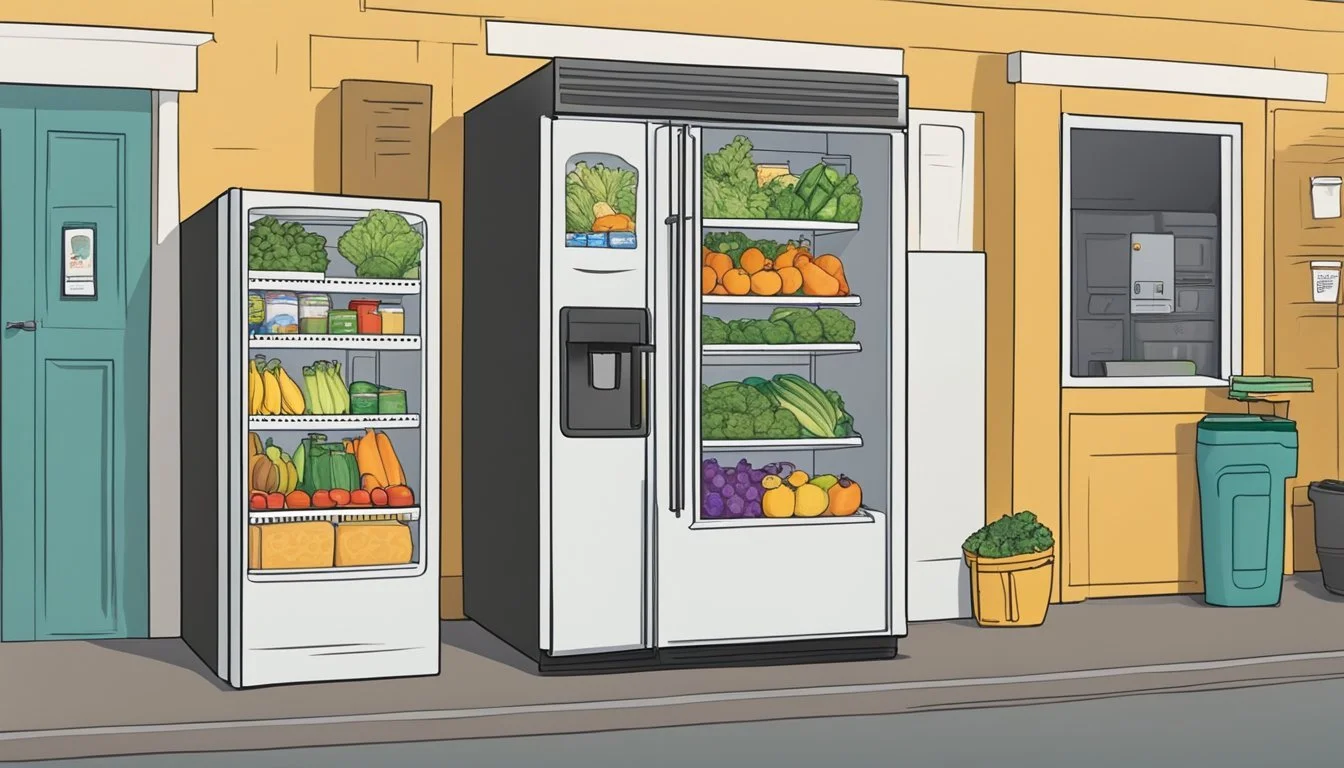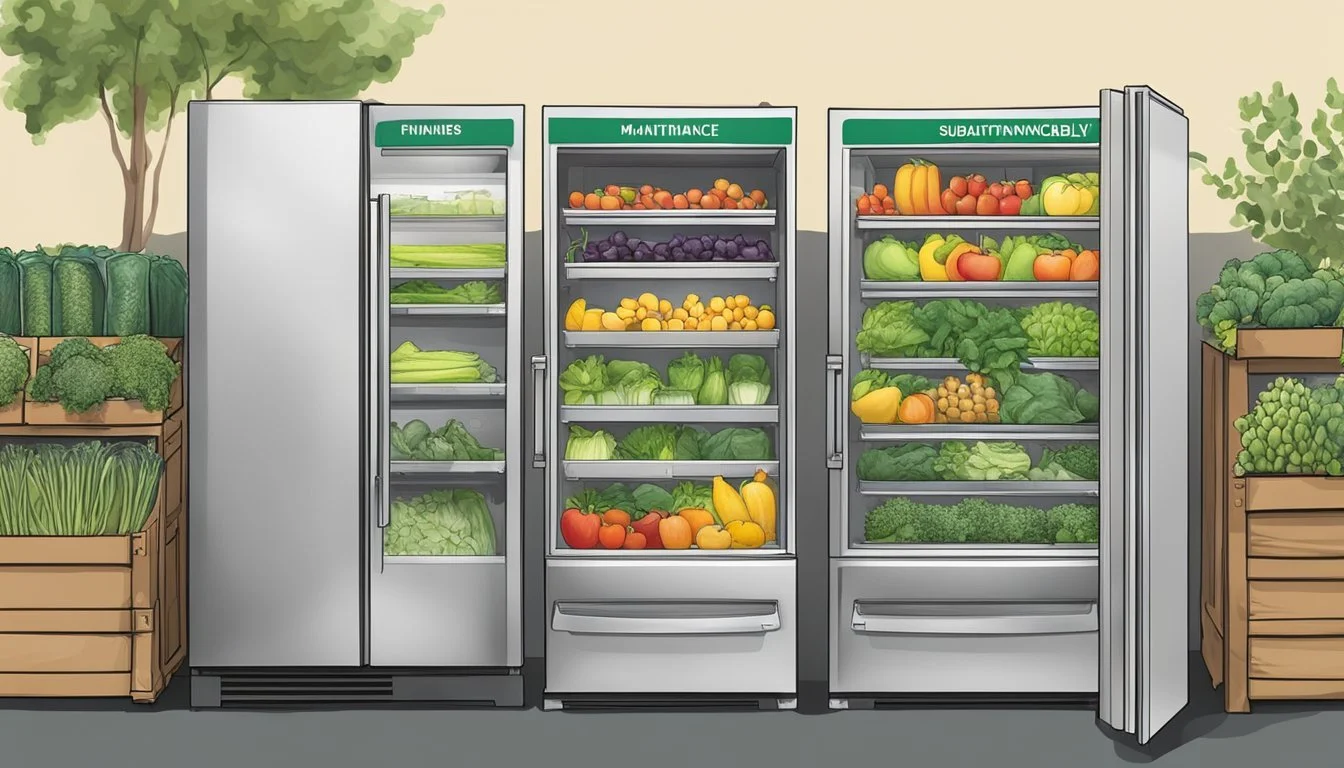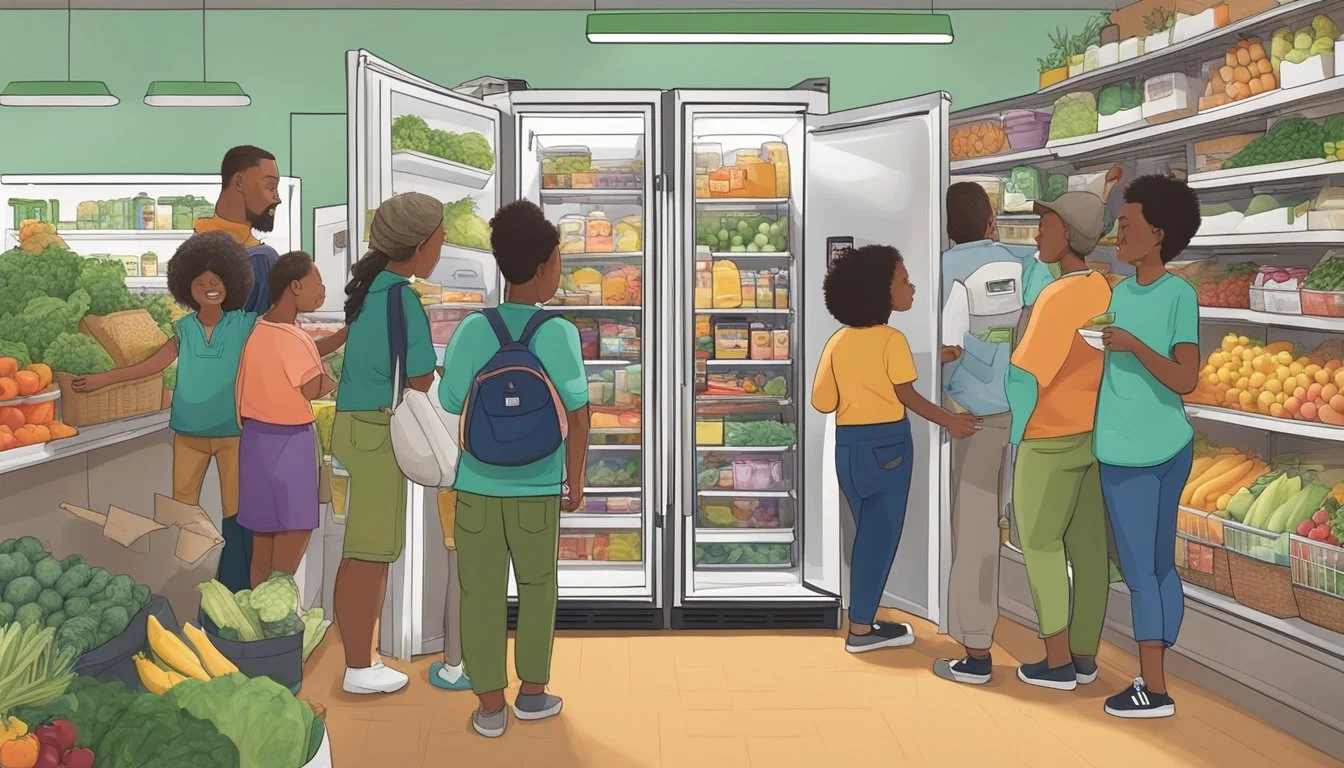Hayward, CA Community Fridge
Bridging the Food Gap for Local Residents
In Hayward, California, an innovative approach to addressing food waste and insecurity has been implemented through the establishment of a community fridge. This initiative provides a network where individuals can contribute to and benefit from a shared resource—the community fridge. Located at Brenkwitz School in Alameda County, this fridge symbolizes a collective effort to offer good food that might otherwise be tossed out, advancing both sustainability and community support.
The essence of the community fridge in Hayward rests on the pillars of sharing and caring, allowing residents to both leave and take food items as needed. The refrigerators act as nodes in a larger network of community fridges, fostering a sense of togetherness among the populace. Through this system, the fridge plays an important role in not just reducing food waste but also in building community resilience.
As the concept gains traction, more individuals in Hayward and beyond are seeing the value in community fridges. They are crucial in helping to combat hunger and promote a community-based solution to food insecurity. Each fridge serves as a testament to the community's commitment to supporting one another, with the potential to inspire similar projects that could weave a tighter fabric of support across neighborhoods.
History and Concept of Community Fridges
Community fridges are rooted in the ethos of mutual aid, addressing food insecurity while fostering trust and cooperation within communities. This novel approach to food sharing allows everyone to participate, bridging gaps in traditional food assistance programs.
Origins of the Community Fridge Movement
The community fridge movement began as a grassroots initiative to combat food waste and alleviate food insecurity. Community fridges, often positioned in public spaces, operate on a simple premise: "Take what you need, leave what you don't." They are filled with surplus food donations—either from businesses or individuals—and anyone can access them.
The concept is predicated on ethics of sharing and collective responsibility. Research into food waste reduction strategies has highlighted community fridges as a viable solution, simultaneously providing food for those in need and reducing the environmental impact of waste.
Community Fridges in Hayward, CA
In Hayward, California, the community fridge initiative reflects the city's commitment to community care and sustainability. They are a manifestation of trust, where residents contribute to and benefit from a shared resource without extensive oversight. This is particularly impactful in urban areas, where the paradox of food waste amidst hunger is most stark. Hayward's community fridges are managed by local groups dedicated to maintaining and stocking the fridges, ensuring the ethics of food distribution and safety are upheld.
How Community Fridges Work
Community fridges operate on the principles of trust and communal responsibility, offering a straightforward approach to sharing food with those in need. They rely heavily on community involvement and adherence to established food donation guidelines.
The Role of Community in Fridge Maintenance
The success of a community fridge hinges on collective labor and oversight. Local residents, businesses, or organizations often collaborate as the owners and caretakers, ensuring the fridge is clean, functional, and stocked. Volunteers are pivotal, routinely checking on the fridge’s condition and removing spoiled items. Maintenance includes tasks such as:
Cleaning the fridge and surrounding area
Stocking and organizing food
Monitoring expiration dates
The community invests in the fridge by providing the labor to maintain it, establishing a foundation of trust that the fridge will be respected and utilized properly.
Food Donation Guidelines and Practices
Strict guidelines govern what can be donated to a community fridge to ensure food safety and quality. Generally acceptable items often include:
Fresh produce
Packaged food with an expiration date
Non-perishable items
Conversely, homemade meals, raw meat, or expired products are typically discouraged due to health risks. Donors must adhere to these practices to maintain the trust and safety of the community-using the fridge. Donors commonly include:
Individuals who contribute excess home-grown produce
Restaurants and grocery stores sharing unsold but still consumable goods
Food banks that distribute surplus inventory
They should ensure all items are safe for consumption and appropriately labelled with dates and contents before placing them in the fridge.
Establishing a Community Fridge
When setting up a community fridge, selecting the right location, acquiring necessary funding, and adhering to regulations are crucial steps in creating a sustainable resource for the community.
Choosing a Suitable Location
Identifying a strategic location within Hayward, CA, is vital. The site should be accessible to those in need as well as those wanting to contribute. Partnering with local businesses and organizations can provide a secure and visible spot that supports frequent contributions and withdrawals from community members.
Visibility: Choose high-traffic areas nearby community centers or shopping areas.
Accessibility: Ensure the location is reachable by public transport and has parking facilities.
Support: Engage with local businesses for possible hosting and maintenance assistance.
Securing Funding and Donations
A community fridge requires fiscal backing for its establishment and ongoing expenses, such as electricity. Local county initiatives and businesses can be approached for support through monetary or in-kind donations.
Initial costs: Possibly include refrigeration units, shelving, and initial stocking of food items.
Recurring costs: Regular expenses like electricity, which may amount to around $150/year in Hayward, CA.
Donation channels: Encourage monetary donations through online campaigns and collection at community events.
Navigating Legal and Health Regulations
Compliance with food safety and legal guidelines is non-negotiable. There must be an evident understanding of the local and county health regulations to ensure the safety of the food distributed.
Draft a clear health and safety protocol.
Regular cleaning schedule must be maintained.
Documentation and tracking systems should be established to monitor food sources and expiration dates.
Business and Economic Impact
Community fridges in Hayward, CA play a pivotal role in shaping the local economic landscape, particularly influencing local businesses and highlighting the importance of corporate social responsibility.
Effects on Local Businesses
The establishment of community fridges within Hayward has had a notable impact on local businesses. These fridges contribute to a supportive network that can reduce food waste from local vendors and provide an avenue for businesses to contribute to societal welfare. They often source excess food from local businesses, which in turn may aid these businesses in managing inventory and reducing disposal costs. Consequently, this can lead to improved business sustainability and create a favorable public image.
Research indicates that businesses participating in food recovery initiatives tend to gain positive recognition which can translate into customer loyalty. In political terms, the support for community fridges by local government can signal a commitment to local economic development and social welfare, fostering a cooperative relationship between political entities and businesses.
Community Fridges and Corporate Social Responsibility
Community fridges are a reflection of an increasing emphasis on corporate social responsibility (CSR) within the business world. By participating in community fridge programs, companies in Hayward not only contribute to the direct well-being of the residents but also demonstrate a commitment to ethical practices. These actions align with broader CSR objectives which can include:
Economic benefits: Reduction in operational waste and potential tax deductions.
Social benefits: Improved access to nutritious food for those in need, bolstering community health.
Environmental benefits: Less food going to landfills, reducing greenhouse gas emissions.
Corporate engagement with community fridges can enhance a company's reputation, fostering a positive relationship with the community. This can have an indirect but substantial economic impact by potentially attracting more customers and improving employee satisfaction and retention.
Maintenance and Sustainability
Community refrigerators play a crucial role in food sharing and waste reduction in Hayward. These initiatives rely on consistent maintenance and adherence to sustainable practices to ensure their longevity and effectiveness.
Handling Repairs and Upkeep
Regular maintenance of the community fridge is essential to avoid food spoilage and ensure a safe environment for food distribution. The local teams responsible for the upkeep of these appliances prioritize appliance repair, including the timely handling of common issues such as compressor malfunctions. They ensure that the labor provided for repairs is ethically sourced and backed by a warranty when applicable, showcasing a commitment to reliability and ethical standards in operation.
Sustainability Practices
Sustainability in the operation of Hayward's community fridge is not just about reducing food waste; it also encompasses eco-friendly practices in managing the appliance itself. The teams involved focus on:
Energy Efficiency: Ensuring the fridge operates with minimal energy consumption.
Ethical Labor: Using repair services that uphold labor ethics.
Longevity: Selecting appliances with a strong warranty to minimize frequent replacement needs.
By adopting these practices, Hayward's community fridge initiative not only reduces waste but also contributes positively to the city's overall sustainability goals.
Choosing a Fridge for Community Use
When setting up a community fridge, selecting the right equipment is crucial to ensure durability and accommodate the volume of shared food. The fridge should be reliable and backed by a solid warranty to inspire trust within the community.
Review of Fridge Models Suitable for Community Use
Manufacturers offer a range of refrigerators that can meet the demands of a community fridge. New fridge models designed for commercial use often have features like heavier gauge shelving, higher grade door seals, and robust cooling systems to handle frequent opening and closing. Here's a list of specific models suitable for community use:
Model A123: This unit is known for high-capacity storage and adjustable shelves, which makes it versatile for different types of food donations.
Model B456: Features an energy-efficient design, helping to keep operational costs low for the community.
Model C789: Equipped with a glass door, this model allows easy viewing of contents, encouraging community participation and minimizing door opening times.
Each model comes with a different set of features and warranty coverage, which is significant for ensuring long-term service.
Assessing Fridge Performance and Reliability
Performance and reliability are two critical aspects of a community fridge. When assessing these, factors such as the refrigerator's cooling consistency, energy consumption, and ease of maintenance should be considered. Trust in the appliance's performance can strengthen community reliance on the service. Here are key points to evaluate:
Cooling Consistency: A fridge must maintain consistent temperatures to ensure food safety. Look for models with positive reviews on temperature reliability.
Energy Consumption: Opt for energy-star rated models that can reduce the community project's carbon footprint and operating costs.
Maintenance: Community fridges require robust construction that withstands frequent use and is easy to clean.
Manufacturer's Reputation: A well-known manufacturer with a track record of reliable appliances is a safer choice.
Lastly, the warranty offered with the fridge is indicative of the manufacturer's trust in its product. A longer warranty period can provide the community with assurance against unexpected costs.
Common Challenges and Solutions
The Hayward, CA Community Fridge undertakes continuous efforts to mitigate issues like vandalism and food safety to provide an ethical and efficient resource for the community.
Vandalism and Security Concerns
The community fridge often faces vandalism and theft, posing security challenges. To combat this, security cameras are installed, and local volunteers regularly monitor the area. The community's involvement in looking after the fridge acts as a deterrent to potential vandals. Additionally, partnerships with nearby businesses provide a sense of oversight, as these entities have a vested interest in maintaining safety and order in their vicinity.
Food Safety and Waste Reduction
Ensuring food safety and reducing waste are paramount concerns for the community fridge. Volunteers adhere to strict guidelines for checking expiration dates and implementing a 'first in, first out' policy to minimize waste. They also maintain rigorous cleaning schedules to uphold health standards. To reduce waste, the community fridge organizers collaborate with local food banks and farms to redistribute surplus goods efficiently and ethically within Alameda County.
Food Donation Guidelines:
Perishables: Label with date of donation
Non-perishables: Check expiration dates before donating
Waste Reduction Strategies:
Regularly check inventory
Partner with food recovery programs
Community Fridge Success Stories
The efficacy of community fridges in Hayward, California, has been underscored by impactful contributions and compelling case studies. These refrigerators serve as a beacon of support, providing food security through the efforts of dedicated individuals and a supportive network.
Local Heroes and Contributors
Notable Contributors:
Eric Von Haynes: Co-founder of a fridge network, instrumental in overseeing 20+ community fridges.
Local Volunteers: Individuals committing time to maintain and stock fridges, ensuring consistent food availability.
Local Organizations:
Brenkwitz School: Host of a notable community fridge, promoting food sharing and waste reduction.
Mutual Aid Groups: Collectives coordinating efforts between donors and community fridges.
Case Studies from Hayward and Beyond
Hayward Community Fridge Impact:
Food Waste Reduction: Significant decrease in food wastage through redistribution.
Food Security Enhancement: Improved access to nutritious food for the community.
Expanded Community Fridge Network:
Growth of Network: Expansion from local to regional, connecting multiple fridges.
Diverse Contributions: Support from varied sources, including individuals, nonprofits, and local businesses.
Highlighted Outcomes:
Throughout the broader area, the network has increased food availability, strengthened community solidarity, and decreased wastage.
Positive feedback loops have emerged, where successes in one area inspire and inform new initiatives in others.
How to Get Involved
Community fridges in Hayward provide an opportunity for individuals and groups to address food insecurity within the county. They rely on a network of volunteers and grassroots organizational efforts.
Volunteering Opportunities
Individuals looking to contribute can join the network of volunteers that supports community fridges in Hayward. Key roles include:
Stocking: Regular checks to replenish the fridge with fresh, acceptable food items.
Cleaning: Maintaining hygiene through scheduled cleaning of the fridge and surrounding area.
Advocacy: Spreading awareness about the fridge's location, purpose, and how it benefits the community.
To volunteer, one may contact local organizations or visit the City of Hayward's official website for contact details such as the Fire Administration at 510.583.4943.
Guides for Starting Your Own Fridge
For those interested in launching a community fridge:
Research: Understand the specific needs of the community and the operational requirements of a fridge.
Partnership: Seek collaboration with community organizations, educational institutions, and service providers.
Location: Identify a suitable, accessible location with high foot traffic.
Maintenance: Ensure a plan for ongoing labor, including cleaning and restocking.
Compliance: Adhere to health and safety guidelines and manage necessary documentation.
Guides are available online for reference on the ins and outs of community fridge maintenance and operation. They include information on costs, such as estimates that a fridge costs around $150 in electricity per year to operate, and outline the measures needed to ensure the food distributed is safe and fresh.
Future of Community Fridges
The proliferation of community fridges has shown promise in addressing food insecurity, and they are poised to benefit from technological innovations and network expansion in the near future.
Technological Advancements
Manufacturers are continually researching ways to make community fridges more efficient and user-friendly. Smart fridges equipped with inventory tracking technology can provide real-time data on food stock, enabling better management and replenishment. They may implement energy-saving features like improved insulation or solar panels, contributing to the sustainability goals of the surrounding county. These advancements help ensure that the choice of food available remains diverse and fresh for longer periods, maximizing the community fridge’s potential.
Expanding the Network
As community fridges gain popularity, efforts to expand the network across diverse regions, including places like Hayward, CA, are underway. Expansion efforts often involve:
Strategic partnerships: Collaboration between local businesses, non-profit organizations, and government entities to establish new fridge locations.
Community engagement: Initiatives to involve local residents in the maintenance and stocking of fridges, fostering a sense of ownership and responsibility.
Accessibility: Ensuring that new fridges are placed in locations that are easily accessible to those most in need, considering both geographic and social factors.
This network expansion signifies a growing awareness of food insecurity issues and a commitment to community-led solutions.












